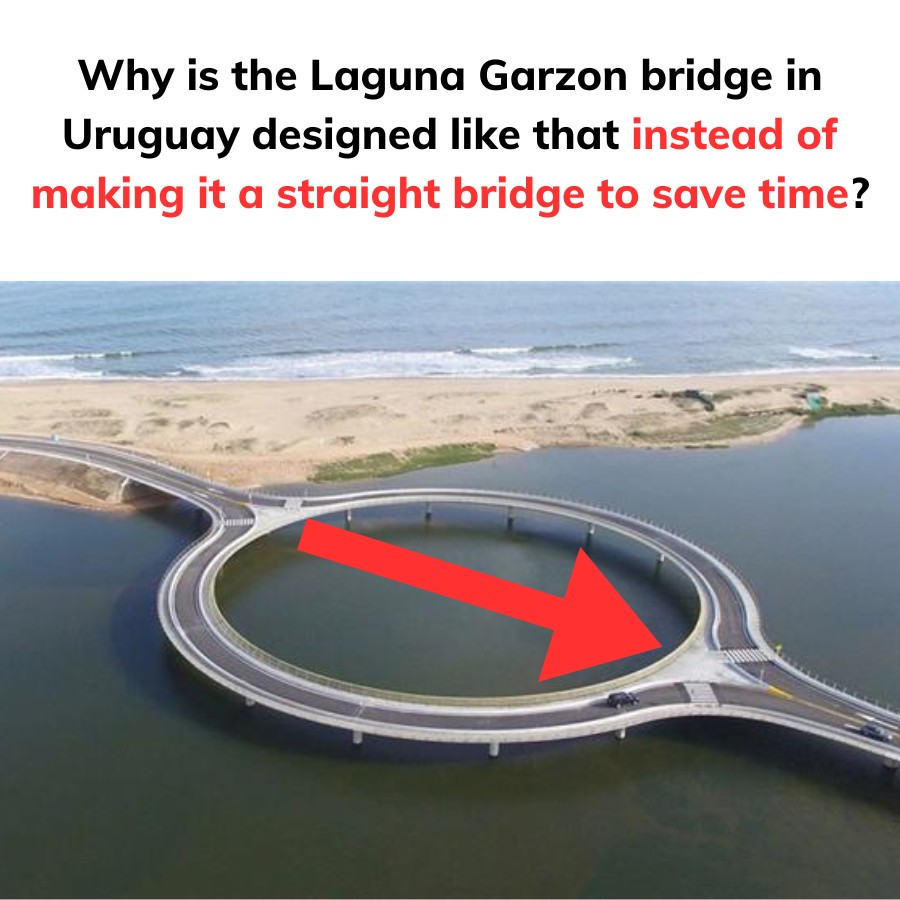When most people think of a bridge, they typically imagine a straight structure stretching across a river, lake, or canyon. But in Uruguay, the Laguna Garzon Bridge defies conventional expectations with its bold, circular design. This architectural marvel isn’t just a striking visual statement—it represents a blend of innovation, safety, environmental responsibility, and artistic brilliance. More than just a functional piece of infrastructure, the bridge has become a symbol of thoughtful engineering and national pride.

At first glance, the bridge appears almost like a sculpture—a graceful circle suspended over the serene waters of Laguna Garzon. Its design immediately grabs attention, sparking curiosity about the purpose behind its unconventional layout. However, the circular shape isn’t merely an aesthetic choice; it serves a very deliberate and functional role, one that sets it apart from traditional bridge designs.
Safety First: Purpose Behind the Circular Design
Traditional straight bridges often unintentionally encourage drivers to speed, posing risks in areas where safety and scenic appreciation should be prioritized. The circular layout of the Laguna Garzon Bridge cleverly addresses this issue. As drivers approach the bridge, the natural curve compels them to reduce their speed, promoting safer driving habits without the need for excessive signage or enforcement measures.
The gentle, looping path requires attention and caution, creating a safer environment for both drivers and pedestrians. It’s not just about getting to the other side—it’s about making the journey itself a mindful and secure experience. This thoughtful approach to safety highlights the innovative vision behind the bridge’s design, proving that infrastructure can be both practical and intentional.
Seamless Integration with Nature
One of the most captivating aspects of the Laguna Garzon Bridge is how harmoniously it blends into its natural surroundings. The architects and engineers didn’t just aim to build a bridge—they set out to create an experience. The circular design invites visitors to slow down, pause, and soak in the panoramic views of the lagoon. Whether walking, driving, or even stopping briefly, the bridge offers unique opportunities to connect with the surrounding landscape.
Moreover, the low-profile construction minimizes disruption to the lagoon’s delicate ecosystem. The design allows water to flow naturally beneath the structure, ensuring minimal interference with local wildlife habitats and aquatic patterns. This eco-conscious approach demonstrates a deep respect for the environment, proving that modern infrastructure can coexist with nature rather than disrupt it.
A Catalyst for Tourism and Economic Growth
Beyond its practical and environmental functions, the Laguna Garzon Bridge has become an unexpected tourist attraction. Its unique design has captured global attention, drawing visitors from around the world who are eager to see this architectural wonder firsthand. Tourists don’t just pass over the bridge—they stop, take photographs, and immerse themselves in the beauty of the surroundings.
This increased foot traffic has had a ripple effect on the local economy. Nearby businesses, restaurants, and tourism services have seen significant growth, turning the bridge into more than just a transportation route—it’s now a landmark destination. The bridge is a prime example of how innovative infrastructure can have far-reaching positive impacts on an entire community.
Sustainability and Innovation at Its Core
The Laguna Garzon Bridge isn’t just an example of creative design—it’s also a testament to Uruguay’s commitment to sustainable development. From the planning phase to construction and completion, every decision was made with ecological responsibility in mind. Engineers carefully assessed the environmental impact, ensuring that the project wouldn’t harm the lagoon’s delicate balance.
This level of care sets an example for other infrastructure projects worldwide. It proves that large-scale construction doesn’t have to come at the cost of environmental destruction. Instead, it can enhance the landscape, provide functionality, and inspire awe—all while minimizing harm.
More Than a Bridge: A Complete Experience
Crossing the Laguna Garzon Bridge isn’t just about moving from one point to another—it’s about being fully present in the experience. The gentle curves encourage drivers to slow down, take a breath, and appreciate the tranquil beauty of the lagoon. Pedestrians can stroll leisurely across the bridge, snapping photos and enjoying the uninterrupted views.
The structure transforms what could have been a mundane commute into something memorable and almost meditative. It serves as a reminder that even infrastructure—something traditionally viewed as purely functional—can offer moments of joy, reflection, and connection with the natural world.
A National Symbol of Progress and Pride
The Laguna Garzon Bridge has grown to become more than just a piece of infrastructure—it’s a symbol of national pride for Uruguay. It represents the country’s ability to think creatively, to innovate beyond conventional boundaries, and to prioritize environmental stewardship alongside progress.
For locals, the bridge serves as a reminder of what’s possible when engineering meets artistry and sustainability. For visitors, it’s an unforgettable experience—a testament to what happens when human ingenuity respects and complements nature.
Final Thoughts: A Visionary Landmark
The Laguna Garzon Bridge isn’t just a way to cross a body of water—it’s a statement. Its circular design, environmental sensitivity, and thoughtful integration into the surrounding landscape redefine what infrastructure can be. It challenges traditional expectations, proving that a bridge can be more than just a means of transportation; it can be a destination, an experience, and an icon.
Whether you’re a traveler passing through, a photographer capturing its elegance, or an environmentalist admiring its sustainable design, the bridge leaves a lasting impression. It’s a shining example of how form and function can coexist harmoniously, and it sets a standard for future infrastructure projects around the world.
In the end, crossing the Laguna Garzon Bridge isn’t just about getting from one side to the other—it’s about experiencing a perfect harmony of innovation, safety, sustainability, and natural beauty. It’s a reminder that great design doesn’t just solve problems—it creates experiences worth remembering.





